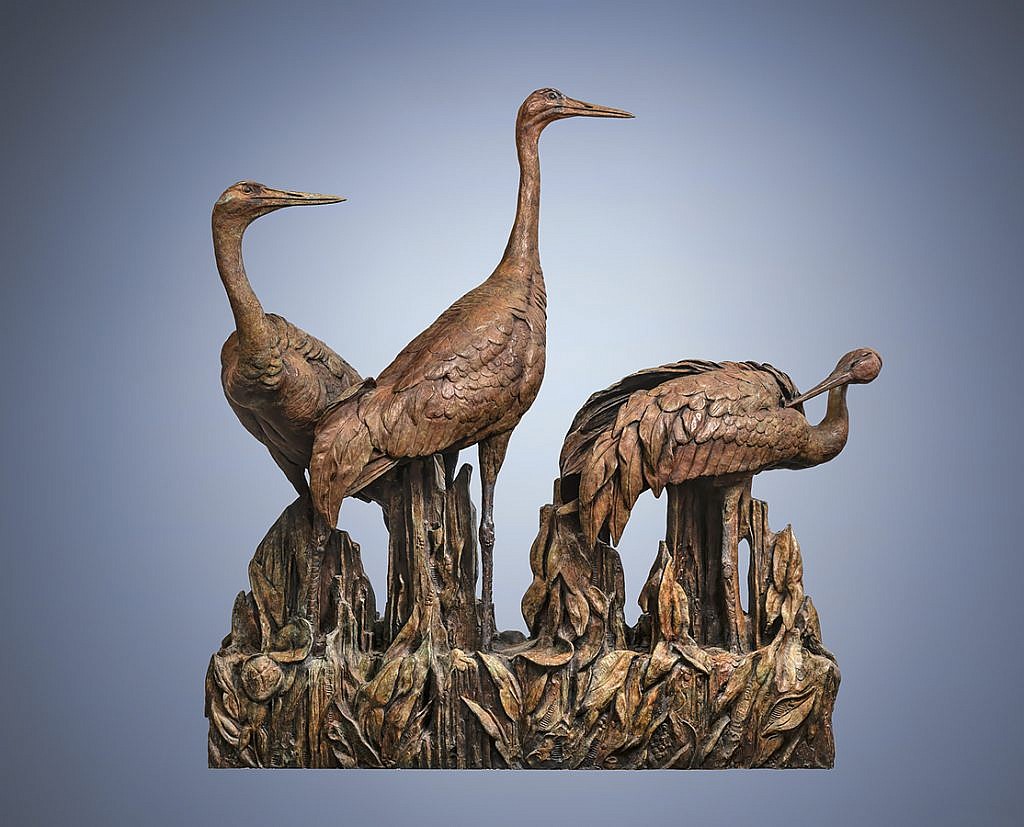
by Brooke Chilvers
But first we went to Walter’s town. Artist C.D. Clarke had been promising for ages to put us all together, hopefully somewhere we’d spot a lot of ducks while I transcribed each artist’s remarks in a remarkable setting.
But Covid changed all that. So, instead, I traced the trajectory from our house to his. Not only was it a reasonable distance for a several-hour visit, it would take us through the gorgeous farmland and horse farms in the country around Sugarloaf Mountain, Maryland.
I’d always felt that Walter (b. 1953) was too young a subject for my column. Artists such as Arthur Shilstone (b. 1922) and David Maas (b. 1929) were much higher on the list. But the years had flown by, and when we arrived at his crammed and busy studio, we were warmly greeted by the tall, fit, outdoorsman and bronze artist, with his fair share of white hair and hard-earned wisdom.
My timing was terrible, for Walter and his assistant, Leeann Krautwurst, were in the midst of organizing his next one-man indoor-outdoor exhibition, Field Notes, at the National Sporting Library & Museum.
From June 18, 2021, to January 9, 2022, the museum’s graceful grounds at the edge of the lively Middleburg, Virginia, will feature seven of Matia’s large-scale works, allowing visitors to study the captivating effects he achieves in bronze in the forms and features of his signature wild turkey, blue-winged teal, great blue heron, and whooping cranes. He is also a master of life-sized hunting dogs, such as A Point of Honor, an art that demands great understanding and communication between artist and owner.

Having marveled for years at his attractive, carefully balanced compositions of (mostly) gamebirds, it was delightful to stand in the wonderland of his original molds, not to mention his inventory of “stock pieces,” such as reeds, cattails, sycamore leaves, and shapely winter branches. His recent arrangement, Busted Covey, of five bobwhite quail, will be heading to the 2021 Oklahoma City “Prix de West.”
The theme of Field Notes reflects Matia’s experience “following dogs, hunkering in blinds, and rambling afield with binoculars in hand.” The binoculars are no surprise because Matia earned degrees in both biology and art design. His library counts hundreds of field guides, right up to The Freshwater Mollusca of the Tennessee River Drainage.
This eclectic marriage of interests served Matia well for his as-yet unknown future as an artist. He apprenticed in the Exhibits Department of the Cleveland Museum of Natural History. His field knowledge of habitat, its citizens and dynamics, made all the difference during his years as vice president of the Nature Conservancy, in charge of land management.
Then he turned full time to art, beginning to cast in bronze in 1980. First came birds, then sporting dogs and other mammals, then fountains and outdoor works for gardens; Blair House, the President’s Guest House, is home to one of them, to which he added a bronze wall frieze in 1992.
The two indoor galleries at NSL&M dedicated to Field Notes feature 23 works about his sporting life over the last decade. Especially original are Matia’s bas reliefs of hunting dogs and game birds, and a bronze fire screen depicting a covey of flushed quail elegantly rising up out of the sunflowers.
Today, Matia is a respected elder of his profession. He has participated for years in numerous art shows and won numerous awards. He has a long list of corporate clients, and is a favorite of all the reputable sporting galleries. He is a champion of conservation and also of his contemporaries’ artwork, which fill the walls of his homestead.
Walter tells me he’s been sculpting often bigger-than-lifesize turkeys for 30 years and suspects these may be his last despite their popularity. When he says turkey hunting evokes “a thousand personal stories of hunting success and failure,” I decline to tell him mine, about the time I went spring turkey hunting in the Ozarks with four other female outdoor writers and ….
______________________________________________________________________________
Brooke Chilvers says the title of her story about that infamous turkey adventure was changed from the original by the publication to a much more polite “Five Babes, Five Birds.”
